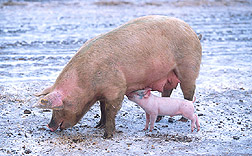This page has been archived and is being provided for reference purposes only. The page is no longer being updated, and therefore, links on the page may be invalid.
Wetlands Curb Hog Hormones in Waste Water
By Jan SuszkiwDecember 18, 2006
Constructed wetlands may help reduce hormones in wastewater from hog farms, an Agricultural Research Service (ARS)-led team reports this month in Environmental Science and Technology.
Recently, hog-farm operators have begun incorporating constructed wetlands into their wastewater treatments to reduce nitrogen and phosphorus in the effluent so that it can be spread onto crop fields without causing environmental harm. But little, if any, research has investigated the system's potential to diminish hormones that hogs excrete into wastewater.
The paper's authors are Nancy Shappell and Lloyd Billey with the ARS Biosciences Research Laboratory in Fargo, N.D.; Dean Forbes and G.P. Reddy of North Carolina Agricultural and Technical State University at Greensboro; and Terry Matheny, Matthew Poach and Patrick Hunt at the ARS Coastal Plains Soil, Water and Plant Research Center in Florence, S.C.
The work dovetails with increasing concern that hormones from livestock waste and other sources are accumulating in the environment and disrupting the endocrine-system function of fish and other aquatic life.
The team's 2004-05 study, conducted at a Greensboro hog-farrowing facility, checked for reproductive hormones—estrogens and androgens (including testosterone) and their metabolites. First, wastewater from the facility went into a manure pit, then into a series of lagoons for microbial degradation. Next, the effluent was pumped into one of four wetlands, then into a storage pond. To close the circuit, some of the "gray" water was flushed back into the barns. The wetland consisted of marsh areas with cattails and pond area, which was either open or covered with floating mats of vegetation.
The researchers took water samples over three seasons in 2004, and weekly in July 2005. They analyzed them for hormones, including a naturally secreted estrogen called estradiol, using liquid-chromatography mass-spectrometry analysis and the E-screen. The latter contains human mammary cells that multiply when exposed to estrogenic compounds.
By analyzing the effluent both before and after passing through the constructed wetlands, they determined the wetlands reduced estradiol activity by 83 to 93 percent. This reduction included estrone, the most prevalent of the estradiol metabolites.
ARS is the U.S. Department of Agriculture's chief scientific research agency.

